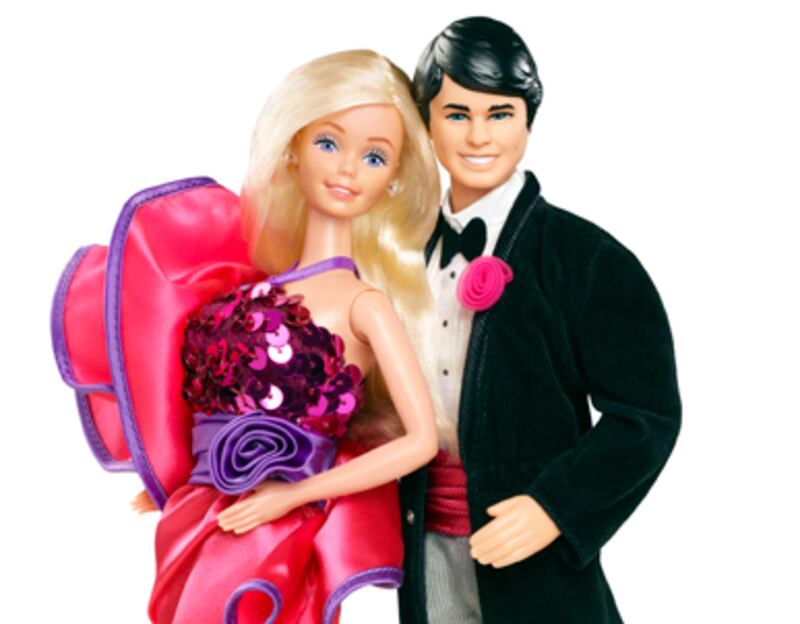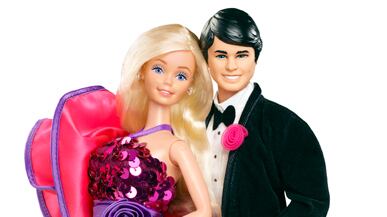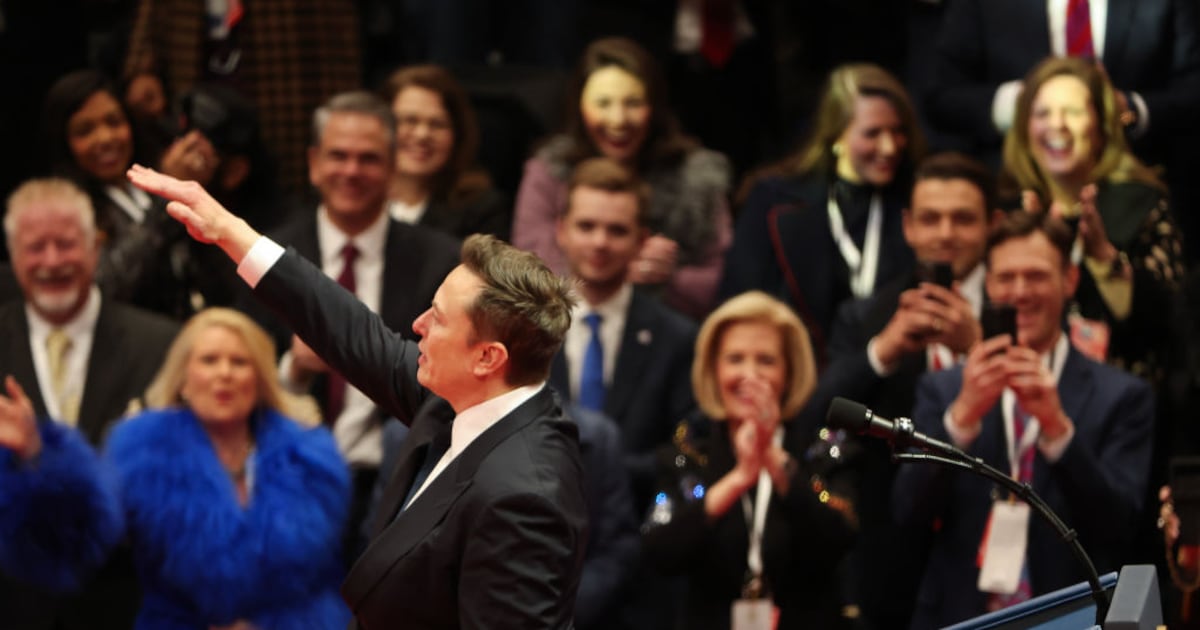For all the heat that Barbie takes for being perfect, her love life is surprisingly human. After splitting up with Ken seven years ago, she briefly flirted with a bronzed Aussie surfer named Blaine. When that fizzled, she decided to "focus on her career"—not a bad call, considering she's bounced between 125 professions in her 52 years. And today, Mattel announced that, after much soul searching, Barbie has shuffled back into her original beau's stiff open arms, for better or worse. Sienna and Jude who?

Over the past few weeks, the toy company has ramped up an elaborate marketing campaign, in which a dapper-looking Ken has taken out billboards across New York and Los Angeles, declaring, "Barbie, I want you back!" He's reminisced on Facebook, Twitter, and FourSquare about their romance. He bought ads in Us Weekly. He even designed a cupcake—Barbie's favorite treat—at Manhattan's hip Magnolia Bakery. ("The wonderful thing about being plastic is that you can eat whatever you want and never gain weight," said Barbie's spokeswoman Michelle Chidoni.) And today, he's proclaiming their love from a virtual mountain: the Times Square JumboTron.
But don't expect girls of Barbie-playing age to know the news: The campaign is targeting adults only. Visit Barbie.com, and nary a hint of the drama exists. "It's play time for grownups," said Tanya Lee Stone, author of The Good, the Bad, and the Barbie: A Doll's History and Her Impact on Us.
In a push to stay relevant in a competitive marketplace, Mattel is banking on American adults' love of celebrity-relationship gossip to turn the Barbie and Ken drama into a sales boom. And in attracting thousands of (largely female) fans, the company is effectively making the bold claim that an entirely fictional relationship isn't all that different from the half-true ones we obsess over in the tabloids.
"Barbie and Ken are celebrities, for better or for worse," said Chidoni. "They live in the spotlight. The benefit is, they're plastic, so it doesn't affect them as much."
But will it affect us?
Unlike most flesh-and-blood stars, Barbie and Ken have been a part of pop culture for three generations. (Fact: Somewhere in the world, a Barbie is purchased every three seconds.) The hope is that their glamorous life as a beautiful, stylish couple, mixed with a little childhood nostalgia, will appeal to adults—adults who might then purchase a Barbie and Ken for the kids in their life. "With real stars, you can never own them, but you can possess Barbie and Ken," said M.G. Lord, author of Forever Barbie: The Unauthorized Biography of a Real Doll.
And Barbie and Ken's allure goes beyond kitsch or nostalgia. "Strawberry Shortcake is never going to be a celebrity," said Cooper Lawrence, author of The Cult of Celebrity: What Our Fascination With the Stars Reveals About Us. "She didn't capture our fantasies the way Barbie does. She doesn't have the legend. She happened in the ‘80s briefly. It's like comparing Madonna to a one-hit wonder."
Ken meets Barbie in Toy Story 3.
Barbie and Ken's relationship has, of course, been public from the start. Shortly after the blond bombshell hit the market as a "teenage fashion model" in 1959, parents who didn't want their daughters adulating a young woman with no apparent designs on marriage clamored for a male suitor. Two years later, Mattel introduced Ken, who became Barbie's "first man," as the company called him. Even Ken's arrival, however, kept the couple ahead of the era's gender norms, as he seemed content to take a backseat to Barbie's ambitions. "Barbie went to the moon before Neil Armstrong did," Chidoni said. "She was a CEO in the ‘80s. Barbie has very much been a trailblazer." All the while, Ken stood smiling by her side, seemingly content to go steady without ever marrying or having kids.
Or genitals. In fact, his passivity has called Ken's very existence into question. Most little girls treat Ken as a servant of sorts, or a prop, Barbie historians told The Daily Beast. He's often given the role of valet for Barbie's pink Corvette, or of short-lived arm candy. "Ken is an afterthought," said Lord. "He's a gnat, a fly, a slave of Barbie. He was only made because, in 1961, as probably today in certain places, a woman would've been seen a failure without a male companion."
Still, the couple stayed together through scandal after scandal. For example: the revelation that Barbie was modeled after a German prostitute cartoon. Or when Mattel debuted Barbie's "Slumber Party" outfit in 1965, which came with a scale permanently set at 110 pounds—and a book titled How to Lose Weight, which contained advice like "Don't eat." Or in 1993, when Mattel introduced " Earring Magic Ken," who sported an earring, lavender pleather vest, and a so-called ring pendant around his neck, sparking rampant speculation about his sexuality.
(In a sad subplot, Ken Handler—son of Mattel's founders, and the man for whom the doll was named—turned out to be a closeted gay man, who felt tortured by the mockery his plastic counterpart received, according to Jerry Oppenheimer in Toy Monster: The Big, Bad World of Mattel. He was diagnosed with AIDS in 1990.)
Then, in 2004: heartbreak. Barbie and Ken split, traumatizing longtime fans. "It was like an earthquake when it happened," said Sandi Holder, who runs a popular Barbie collectors' business in Northern California, and is the author of Barbie: A Rare Beauty. Enter Blaine, a new addition to Barbie's beach line. "You knew it was coming," said Lord. "But the pool boy?"
Mattel announces Barbie and Ken’s breakup at a 2004 press conference.
Starting in 2006, Ken began trying to woo Barbie back. He enlisted a celebrity stylist. He got a makeover. And finally, last year, things started coming together for him. He got a role in the Oscar-nominated Toy Story 3. He played Don Draper in Barbie's Mad Men line. He got yet another makeover—just in time for his 50th birthday—and now looks a bit like Justin Bieber. And readier than ever for love, he even joined Match.com, where he discovered that Barbie had also signed up. (Barbie and Ken! They're just like us!).
Guess who’s on Match.com?
Social media followers are thrilled that Barbie and Ken were able to rekindle their love. Though to be sure, "It's almost like learning that your elderly relatives are getting back together," said Lord.
For the decades of (rightful) scrutiny Barbie's been subjected to for representing unrealistic beauty ideals and unbridled materialism, it's nearly impossible not to think about her as representing more than just a toy. As Robin Gerber, author of Barbie and Ruth: The Story of the World's Most Famous Doll and the Woman Who Created Her, points out, Barbie's dilemma over whether to take Ken back may reflect larger societal trends. "Barbie has become rather intelligent and professional. That really tracks with women today, and with the question: Are women going to be forced to marry ‘beneath them'? She's been such a high-flier. Is Ken good enough? Maybe she was dating a surfer because that's all she could find."
(To which Barbie's spokeswoman assures: "Ken is an icon in his own right. He's had a number of careers. He's taken a little bit of a backseat to Barbie, but Ken is the ultimate boyfriend for every occasion.")
As for Barbie's happiness with her original love, time and their Facebook statuses will tell. Little girls might have some insight, too: In the campaign's one crossover with Mattel's kids market, the toy company is selling a packaged set of Barbie and Ken dolls for Valentine's Day, their fates now left to fickle 5-year-old imaginations. The company also just released a new " Sweet Talkin' Ken" doll. Users can press a button on his chest and record a message, which the doll repeats back in a man's voice or, if you so choose, a squeaky high-pitched one. Ken should probably hold on to his publicist.
In the meantime, for all Barbie's baggage when it comes to setting impossible ideals, there's something comforting about her relationship saga—in the same way that it can be reassuring to read that celebrities, just like us, have to contend with heartache, despite all the money and good looks. If Barbie and Ken, a couple that was literally made for each other, have their ups and downs, there might be hope for the rest of us.
Danielle Friedman is a homepage editor and reporter for The Daily Beast. Previously, she spent five years working as a nonfiction book editor for Hudson Street Press and Plume, two imprints of Penguin Group. She's a graduate of the Columbia University Graduate School of Journalism.






